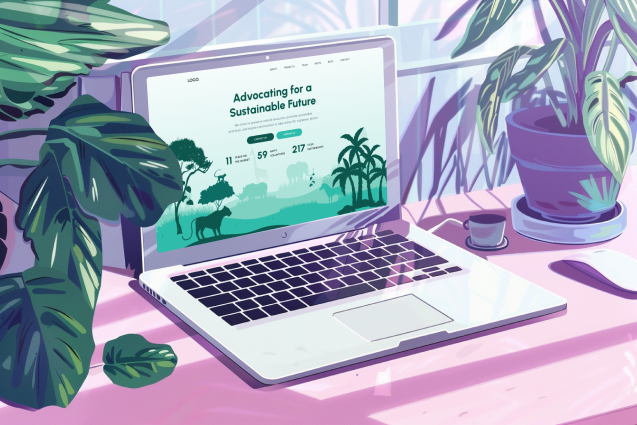When it comes to large tech and e-commerce sites, the environmental impact is staggering. For instance, Amazon’s website alone emits an estimated 400,000 kilograms of carbon dioxide equivalent per month per page view. Surprising, right?
Did you ever consider the carbon emissions your own website might produce? Or that a website, even a small one, could have a real environmental impact? With sustainability becoming an essential part of modern business practices—not just in fashion but across digital spaces—it's time to consider sustainable web design.
In this guide, you’ll learn what sustainable web design truly means and how to make your own eco-friendly website, aligning with today's environmentally conscious movement. Let's dive into making your website a little greener and kinder to our planet.
Start Today!
How big of a threat is the Internet in terms of generating pollution?

The internet, surprisingly, is a major player in global pollution. It’s responsible for nearly 1 billion tonnes of greenhouse gases each year. In fact, the internet currently produces about 3.7% of global carbon emissions—and that percentage is only rising as our data consumption increases. To put this into perspective, if the internet were considered a country, it would rank as the 4th largest polluter in the world.
More than 66% of the world’s population now uses the internet, with global users numbering over 5.35 billion. And it's not just the number of users that matters—the typical internet user spends around 6 hours and 40 minutes online every day. This collective digital activity generates a vast carbon footprint, making it clear that sustainable web design isn't just a nice-to-have; it's a necessity.
Understanding the scale of internet pollution highlights just how much potential we have to make an impact by building more eco-friendly websites.
Is your website really bad for the planet? How much pollution does it produce?

Every website leaves a carbon footprint—and whether it's a big or small impact depends largely on the site’s design, content, and hosting choices. On average, a single web page generates about 0.8 grams of CO2 per page view. If a website has 10,000 page views per month, that’s about 102 kg of CO2 per year!
But how do websites actually produce pollution? A few factors come into play:
- Hosting servers that consume vast amounts of energy to stay online.
- Large files like high-resolution images, videos, and complex scripts that require more data to load.
- High traffic volume, with every user’s visit generating emissions from the data transfer process.
So why isn’t making websites greener a higher priority for most businesses? According to a recent survey, 38% of respondents cited “limited knowledge of the environmental impact” as the main reason. Many businesses and creators simply don’t realize that digital actions contribute to pollution—yet that awareness is the first step toward a more sustainable web design approach.
Creating an eco-friendly website is more accessible than most people think, and every small change contributes to reducing this impact.
What is sustainable web design?
With the shocking data about internet pollution, it’s no surprise that green website design has become a thing. But what exactly does sustainable web design mean, and how can a website be eco-friendly?
At its core, a sustainable website is one that’s designed to minimize its environmental impact. The goal is to create a site that is kind to the planet, where every element—design, coding, hosting, and content—is crafted to reduce its carbon footprint as much as possible.
From using eco-friendly hosting to optimizing files for quicker load times, sustainable web design practices aim to make the entire digital experience leaner, faster, and less energy-intensive. Essentially, it’s about creating a website that serves your audience without harming the environment.
It may sound ambitious, but with a few mindful changes, anyone can create a low-carbon website that’s both eco-friendly and effective.
How to check the website sustainability score?
Tracking carbon emissions from websites can be quite challenging. While achieving complete accuracy in measuring these emissions is difficult and not always 100% reliable, there are many tools available that can help you assess your website's sustainability.
One popular option is the well-known SEO tool Screaming Frog. This software estimates your site's CO2 emissions by analyzing data and offering insights into potential areas for improvement.
Another handy resource is Website Carbon. This website will estimate your web page's carbon footprint by analyzing various factors and providing you with a sustainability score. These tools can help you gauge where your site stands in terms of website sustainability and identify opportunities to reduce its environmental impact.
Checking your website’s sustainability score is a great first step toward making it more eco-friendly and reducing its overall footprint!
How to make a sustainable website?

Creating a sustainable website means making intentional choices to reduce its carbon footprint, optimize performance, and align with eco-friendly practices.
Here are some essential steps to help your website become greener and more energy-efficient:
1. Use green web hosting
Switching to a green web hosting provider is one of the easiest and most impactful changes you can make. A green hosting company relies on renewable energy sources to power its data centers, reducing the environmental impact of your website. According to a recent survey, 51% of SEO experts ranked green web hosting as the number one strategy for reducing website emissions.
Hosting choice matters not just for sustainability but also for performance. When a website takes longer to load, it consumes more server energy, which means a higher carbon footprint. Additionally, the further your website data has to travel from the server to the end user, the more energy is required, resulting in more CO2 emissions.
To reduce this travel distance and energy use, consider using a Content Delivery Network (CDN). CDNs store copies of your website on multiple servers around the world, meaning your content is delivered from the server closest to the user. This minimizes load time, reduces energy consumption, and ultimately lowers your site’s environmental impact.
2. Use clean code to create a website
Clean code is fundamental to sustainable web design. By writing efficient, minimal code, you’re not only improving your website’s performance but also reducing the energy it takes to load each page. Here’s how you can achieve a cleaner, more eco-friendly website:
- No unnecessary code: Avoid cluttering your website with extra code or plugins that don’t add real value. Each piece of unnecessary code slows down your site and increases energy use.
- Use less JavaScript: JavaScript can be powerful, but it’s also one of the most resource-intensive code types. Use it only where essential, and optimize it to minimize load times.
At BOWWE, we prioritize creating websites with clean code, ensuring that only essential elements are included. Our platform continually works on optimizing tools and code to keep them efficient and eco-friendly.
3. Delete unnecessary tracking scripts and plug-ins from your website code

It’s easy to think, “But I need all of these tools!”—but the truth is, you probably don’t. Many sites become bloated with extra tracking scripts and plug-ins that add to your website’s carbon footprint by slowing down load times and increasing server demand. Luckily, there are simpler solutions to get the data you need without all the extra weight.
Today, consolidated tools like Google Analytics 4 and Google Search Console can often provide all the insights you need about your website’s performance and user behavior. Instead of stacking multiple tools and trackers, these basics often suffice.
At BOWWE, we also offer a set of internal statistics tools that give you accurate, in-depth data about your website’s performance. This way, you have essential analytics without overloading your site with unnecessary scripts!
4. Make sure your website loads quickly
Fast loading times are key to a sustainable website. The quicker a page loads, the less energy it uses—making your site more eco-friendly and improving user experience. Here are some steps to speed up your website:
- Minimize Cumulative Layout Shift (CLS): CLS measures unexpected layout shifts that happen during page load. A high CLS score means your site is struggling to stabilize content as it loads, which can slow down performance. Keeping CLS low ensures a smoother and faster user experience.
- Limit the number of files: The fewer files your website has to load, the faster it will be. Reduce image sizes, optimize code, and minimize large file formats to improve load times.
To check how fast your website currently loads and identify areas for improvement, you can use Google’s PageSpeed Insights test. This tool provides insights into your site’s performance and highlights elements that may be slowing it down.
Beyond sustainability, page speed is a crucial factor for SEO, meaning that a faster site can boost your search engine rankings. Optimizing your website’s load time not only makes it more eco-friendly but also helps it perform better in search results, bringing in more traffic and enhancing user satisfaction.
Start Building
No coding experience required.
5. Optimize your media

Media files, especially images and videos, are often the biggest energy drain on websites. Large, unoptimized media files not only slow down load times but also increase carbon emissions. Here’s how you can optimize your media to create a more eco-friendly website:
- Switch to WEBP format: The WEBP format compresses images more efficiently than standard formats like JPEG or PNG without sacrificing quality. This results in smaller file sizes, faster load times, and lower energy consumption.
- Reduce media sizes: Always resize images to the exact dimensions needed for display. This prevents your site from loading oversized files that take up unnecessary bandwidth.
- Use lazy loading: With lazy loading, media files only load when the user scrolls to them, reducing initial load times and saving energy. In BOWWE, enabling lazy loading is simple—just check the box in the image widget settings, and you're set!
If you’re just starting to create your website, make it a habit to optimize file sizes and formats from the beginning. Trust me—avoiding that dreaded “wake-up call” when you realize hundreds of images and videos need to be optimized will save you time, stress, and energy.
6. Use eco-friendly fonts
Fonts may seem like a minor detail, but every font type—including different weights, bold, and italic styles—requires a separate file to load. This means that using many font styles can slow down your website and increase its carbon footprint. To make your website more sustainable, consider these font optimization tips:
- Limit the number of font styles: Stick to a minimal set of fonts and avoid multiple weights or styles unless absolutely necessary. This reduces the number of files that need to be loaded, speeding up your website.
- Use the WOFF2 format: For the best performance, choose WOFF2, a modern web font format that compresses font files efficiently, reducing load times and energy use.
- Remove unused characters: If you don’t need certain characters (like specific symbols or language sets), trim them from the font file. This will decrease the file size and minimize the environmental impact.
By choosing eco-friendly fonts and keeping font use minimal, you’re making a simple yet impactful change toward sustainable web design. Thoughtful font choices contribute to a faster website, a lower carbon footprint, and a better user experience!
7. Make a thoughtful SEO strategy

A well-planned SEO strategy isn’t just about ranking higher—it’s also about improving your website’s sustainability. Sustainable SEO empowers users to find what they need in fewer clicks, reducing unnecessary page loads and minimizing your website’s environmental impact. Here’s how to optimize your SEO for a greener web experience:
- Streamline the user journey: Optimize buying and navigation journeys so users can find what they’re looking for quickly and easily, encouraging conversions in fewer steps. This reduces the time users spend browsing and lowers the site’s carbon footprint.
- Satisfy user intent as soon as possible: When your website aligns closely with user intent, visitors reach their goal faster, which improves user experience and makes your website more efficient.
- Utilize SEO tools: With BOWWE Website Builder’s in-built SEO module, you can easily optimize your site for search engines, allowing users to find your content quickly. BOWWE’s tool makes it simple to create an eco-friendly website with a robust SEO strategy in place.
Sustainable web design – summary
Is creating a truly sustainable website easy? Not necessarily. And yes, making a site eco-friendly can take time and effort—especially if you're trying to retrofit an existing site to be more eco-friendly. But taking these steps is worth it, both for the planet and for your audience’s experience.
At BOWWE, we’re dedicated to making our platform more sustainable every day. We work to reduce unnecessary code, phase out external tools, and develop internal resources that enable you to run your website with fewer external dependencies. It’s a big project but an essential one 😉🌳
While the concept of sustainable web design may still be in its early stages, it’s gaining traction as more people and businesses recognize the importance of reducing their digital footprint. So why wait? Let’s start making our websites a part of the solution for a greener, more sustainable future today.
Start Today!
Sustainable website - FAQ
Can a website be eco-friendly?
Yes, a website can be eco-friendly by focusing on practices that reduce its environmental impact. Sustainable web design incorporates elements like efficient coding, reduced media sizes, green web hosting, and optimized SEO strategies to decrease energy consumption.
What is sustainable web design?
Sustainable web design aims to create websites that use less energy and leave a smaller carbon footprint. This approach involves optimizing code, images, fonts, and more to keep the website light and efficient. The goal of sustainable web design is to balance functionality and aesthetics while making the site as resource-efficient as possible, benefiting both the planet and user experience.
How to make a sustainable website?
To create a sustainable website, start with green web hosting, optimize images and media, use minimal tracking scripts, and ensure clean, efficient code.
What is sustainable UX design?
Sustainable UX design focuses on creating user experiences that are not only intuitive and pleasant but also energy-efficient. It involves designing layouts and navigation paths that require minimal server load, optimizing user journeys to reduce the number of clicks or page views, and prioritizing accessible, lightweight interfaces. Sustainable UX design keeps user satisfaction high while reducing the digital footprint of a website.

Karol is a serial entrepreneur, e-commerce speaker m.in for the World Bank, and founder of 3 startups, as part of which he has advised several hundred companies. He was also responsible for projects of the largest financial institutions in Europe, with the smallest project being worth over €50 million.
He has two master's degrees, one in Computer Science and the other in Marketing Management, obtained during his studies in Poland and Portugal. He gained experience in Silicon Valley and while running companies in many countries, including Poland, Portugal, the United States, and Great Britain. For over ten years, he has been helping startups, financial institutions, small and medium-sized enterprises to improve their functioning through digitization.







